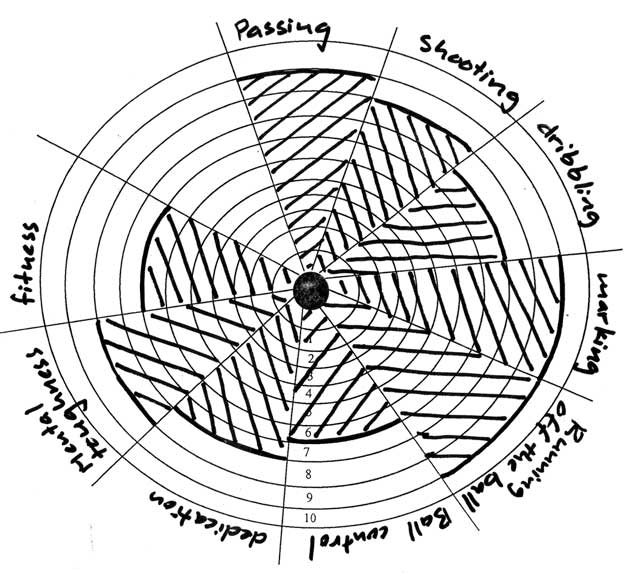An example of a completed performance profile.
Personal Construct Theory states that each individual uses their previous experiences to create a framework for making sense of the world around them. This is to say that although we may all observe the same information, the ways in which we interact with, and act on, it will differ as a direct result of the personal beliefs we’ve developed. Therefore, each athlete has individual opinions on what constitutes success and challenge, and will come to their own conclusions regarding what attributes are required for progressing their own abilities. Performance profiling is empowering, as it hands over agency of the evaluation process to the athletes themselves, and allows comparison between external views of their performance, and their individual assessment.
As noted above, performance profiling offers a unique insight into not only an athlete's strengths and weaknesses, but also their understanding of what it takes to perform at an elite level in any given craft. The information gathered from performance profiling exercises can be used to inform goal setting, and support autonomy by aligning training with their individual needs. With this in mind, setting aside time throughout the season for athletes and coaches to assess, monitor, and reflect on the development of their personal attributes is an intentional and efficient use of everyone’s time.
This handy PDF, free to download and distribute, can be a useful starting point for all coaches, instructors, and leaders looking to try performance profiling with their teams and athletes! A description of how to make use of it is provided below.
Performance profiling is best tackled as a two part exercise.
First, ask athletes to reflect on the attributes which are important for being an elite performer in their discipline. It can be beneficial to break these down into equal quantities of physical, mental, technical, and tactical attributes. This helps gain a well-rounded view of performance. Further, ask the athletes to define each of these attributes. This allows them to fully articulate each attribute, and provides clarity around potentially vague terms such as “speed” or “toughness”.
Second, have the athletes transfer these attributes onto the performance profiling wheel. This asks the athletes to objectively evaluate themselves on a 1-10 scale for each attribute, with 1 being the worst possible performance, and 10 being the best an athlete in your discipline could perform. By marking these ratings onto the wheel, athletes will create a personal visual representation of their strengths, and attributes which they can benefit from improving.
By allowing athletes to evaluate their own performance and attributes in this manner, coaches and leaders can gain insights above and beyond their own assessments. This allows discussion around differences and discrepancies to flow, and to be addressed. Performance profiling can be done at any point during a cycle, but for best results, try using them periodically and logically. For example at the beginning, middle, and end of the season. This lets progress to be measured, and keeps them fresh in the minds of athletes and coaches alike.
To conclude, performance profiling is an exercise which can improve motivation, training specificity, and consequently performance of teams and athletes. This is in addition to allowing insight into the athlete’s view of performance, while honoring their individual experiences. If this article prompts you to try performance profiling with your teams, please let us know!
Mzk Performance also conducts consultations and workshops where we deliver mental skills and mindset training and exercises to athletes, coaches, and leaders. For more information get in contact. Thanks for reading!


